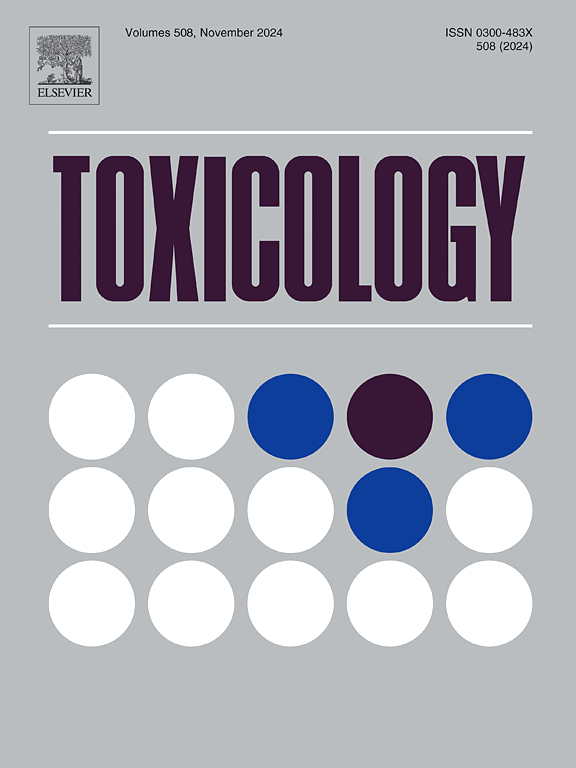Bisphenol S exacerbates CRC progression through dual mechanisms of immune microenvironment reprogramming and SLC4A2-mediated EMT activation
IF 4.6
3区 医学
Q1 PHARMACOLOGY & PHARMACY
引用次数: 0
Abstract
Bisphenol S (BPS) is frequently utilized in the domain of food packaging materials as well as in the sphere of industrial plastic manufacturing. Although existing studies suggest potential associations between BPS exposure and the development of various malignancies, the exact biological function of BPS in colorectal cancer (CRC) advancement is still not fully understood. This research intends to thoroughly explore how BPS influences the malignant characteristics of CRC at the molecular level, particularly its impact on the epithelial-mesenchymal transition (EMT) in tumor cells. This study employed a LASSO regression model to screen key genes associated with BPS exposure in CRC progression and constructed a prognostic prediction model. The ESTIMATE algorithm was employed to evaluate the stromal and immune scores within the tumor microenvironment, while the CIBERSORT technique was applied to examine the infiltration profiles of 22 distinct immune cell subsets. The impact of BPS on HCT8 cell proliferation, migratory ability, and EMT progression were systematically evaluated through Western blot, CCK-8 proliferation assays, scratch wound healing experiments, and Transwell assays for migration and invasion. BPS exposure within the concentration range of 10⁻¹ ⁰ to 10⁻⁶ M did not significantly inhibit HCT8 cell viability but markedly enhanced migration and invasion capabilities, accompanied by EMT progression. A prognostic model constructed from nine key genes linked to BPS and determined via LASSO regression exhibited robust predictive efficacy. Tumor microenvironment analysis indicated a substantial association between SLC4A2 gene expression and activated memory CD4 + T lymphocyte infiltration. Notably, BPS exposure specifically induced SLC4A2 upregulation, while siRNA-mediated SLC4A2 knockdown significantly suppressed BPS-induced cell migrationand reversed EMT phenotypes. This study first demonstrates that BPS promotes CRC cell migration by activating the EMT signaling pathway via SLC4A2 upregulation. SLC4A2, being a key player in BPS-induced tumorigenesis, could function as a promising biomarker and therapeutic target for CRC. These findings not only elucidate the molecular mechanisms underlying environmental pollutant-induced carcinogenesis but also provide experimental evidence for developing prevention strategies targeting BPS-associated CRC risks.
双酚S通过免疫微环境重编程和slc4a2介导的EMT激活的双重机制加剧了CRC的进展
双酚S (BPS)经常用于食品包装材料领域以及工业塑料制造领域。尽管现有研究表明BPS暴露与各种恶性肿瘤的发展之间存在潜在关联,但BPS在结直肠癌(CRC)进展中的确切生物学功能仍未完全了解。本研究旨在深入探讨BPS如何在分子水平上影响结直肠癌的恶性特征,特别是其对肿瘤细胞上皮-间质转化(epithelial-mesenchymal transition, EMT)的影响。本研究采用LASSO回归模型筛选与BPS暴露相关的CRC进展关键基因,构建预后预测模型。使用ESTIMATE算法评估肿瘤微环境中的基质和免疫评分,而使用CIBERSORT技术检查22种不同免疫细胞亚群的浸润谱。通过Western blot、CCK-8增殖实验、划伤愈合实验和Transwell迁移和侵袭实验,系统评估BPS对HCT8细胞增殖、迁移能力和EMT进展的影响。10⁻¹ ⁰到10⁻26 M浓度范围内的BPS暴露并没有显著抑制HCT8细胞的活力,但明显增强了迁移和入侵能力,伴随着EMT的进展。由9个与BPS相关的关键基因构建并通过LASSO回归确定的预后模型显示出强大的预测功效。肿瘤微环境分析提示SLC4A2基因表达与活化记忆CD4 + T淋巴细胞浸润有实质性关联。值得注意的是,BPS暴露特异性诱导SLC4A2上调,而sirna介导的SLC4A2敲低显著抑制BPS诱导的细胞迁移和逆转EMT表型。本研究首次证实BPS通过上调SLC4A2激活EMT信号通路,从而促进结直肠癌细胞迁移。SLC4A2在bps诱导的肿瘤发生中起着关键作用,可以作为CRC的一个有前景的生物标志物和治疗靶点。这些发现不仅阐明了环境污染物致癌的分子机制,也为制定针对bps相关CRC风险的预防策略提供了实验依据。
本文章由计算机程序翻译,如有差异,请以英文原文为准。
求助全文
约1分钟内获得全文
求助全文
来源期刊

Toxicology
医学-毒理学
CiteScore
7.80
自引率
4.40%
发文量
222
审稿时长
23 days
期刊介绍:
Toxicology is an international, peer-reviewed journal that publishes only the highest quality original scientific research and critical reviews describing hypothesis-based investigations into mechanisms of toxicity associated with exposures to xenobiotic chemicals, particularly as it relates to human health. In this respect "mechanisms" is defined on both the macro (e.g. physiological, biological, kinetic, species, sex, etc.) and molecular (genomic, transcriptomic, metabolic, etc.) scale. Emphasis is placed on findings that identify novel hazards and that can be extrapolated to exposures and mechanisms that are relevant to estimating human risk. Toxicology also publishes brief communications, personal commentaries and opinion articles, as well as concise expert reviews on contemporary topics. All research and review articles published in Toxicology are subject to rigorous peer review. Authors are asked to contact the Editor-in-Chief prior to submitting review articles or commentaries for consideration for publication in Toxicology.
 求助内容:
求助内容: 应助结果提醒方式:
应助结果提醒方式:


